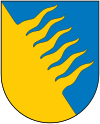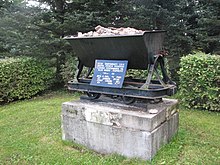Kohtla-Järve
| Kohtla-Järve | |||
|
|||
| State : |
|
||
| Circle : |
|
||
| Founded : | 1946 (city rights) | ||
| Coordinates : | 59 ° 24 ' N , 27 ° 16' E | ||
| Area : | 54.02 km² | ||
| Residents : | 34,394 (January 1, 2018) | ||
| Population density : | 637 inhabitants per km² | ||
| Time zone : | EET (UTC + 2) | ||
| Community type: | city | ||
| Structure : | six districts | ||
| Mayor : | Jevgeni Solovjov
( Keskerakond ) |
||
| Postal address : | Keskallee 19 30395 Kohtla-Järve |
||
| Website : | |||

|
|||
Kohtla-Järve is an industrial city in northeast Estonia . Its history is closely linked to the mining of oil shale since the 1920s. It is the fourth largest city in the country.
Location and population
Kohtla-Järve is located in the Ida-Viru district ( Ida-Viru maakond ), not far from the Estonian Baltic coast . Kohtla-Järve has 43,817 inhabitants (as of January 1, 2012).
The city's population declined sharply after Estonian independence was regained in 1991. It has halved compared to the late 1970s. This is explained on the one hand by the spin-off of the again independent cities Jõhvi , Püssi and Kiviõli . On the other hand, the collapse of Soviet heavy industry has left negative economic consequences. Many formerly Soviet companies became unprofitable and had to close. Unemployment is still high. As in all cities in the district, the demographic development is still negative.
The Slavic-speaking population makes up about eighty percent. In the 2000 census, 68.9% identified themselves as Russians , 17.8% as Estonians , 4.5% as Belarusians and 2.3% as Ukrainians. Most of the families were brought to Kohtla-Järve as industrial workers from other parts of the Soviet Union after the Second World War .
Population development
| year | 1959 | 1979 | 1989 | 1994 | 1998 | 2000 | 2004 | 2007 | 2010 | 2012 | 2017 | 2018 |
|---|---|---|---|---|---|---|---|---|---|---|---|---|
| Residents | 56,000 | 87,472 | 62,059 | 56,600 | 52,611 | 47,679 | 46,346 | 45,399 | 44,492 | 43,817 | 35,056 | 34,394 |
Territorial division
A specialty of Kohtla-Järves is the territorial fragmentation of the urban area. The districts are forty kilometers apart in an east-west direction. The double name of the city is derived from the villages of Kohtla and Järve.
The city consists of six unconnected districts. This can be explained by the founding of the city after the Second World War , when several localities were merged to form the socialist industrial and working-class town of Kohtla-Järve. After Estonian independence was regained, individual parts of Kohtla-Järves were spun off again as independent local authorities in the 1990s.
The five districts of Kohtla-Järves are Ahtme (on the adjacent map no. 1), Järve (no. 2), Oru (no. 3), Sompa (no. 4) and Kukruse (no. 5). Ahtme and Järve are by far the two most populous districts with around 16,000 inhabitants each (as of December 31, 2011).
The city administration is located in the Järve district, which is characterized by its socialist architecture.
history
The first mention of the places Järve ( Jeraius ) and Kukruse ( Kuckerus ) as well as the now defunct village Tõrvasküla ( Terauscula ) took place in 1241. They are listed in the Liber Census Daniae , a Danish tax register. The village of Sompa ( Soenpa ) is also relatively old; it was first mentioned in documents in 1420. The goods of Kohtla ( Kochtel ), Sompa ( Sompäh ) and Järve ( Türpsal ) are documented for the 15th century .
Oil shale played an important role in the development of the region . It is the most important natural resource in Estonia with a total deposit of an estimated six billion tons.
Burning shale was first localized near Kukruse in the 1870s and mined to a small extent. Immediately before the First World War and in the interwar period, more abundant deposits were discovered and mined in the area. Trial dismantling began in 1916/17.
In 1922 the AS Riiklik Põlevkivitööstus company was founded. In 1924 the first slate processing factory was built; two more followed in 1936 and 1938. A refinery was commissioned in 1931. At the same time the workers' settlement Kohtla-Järve was built; their area is now called "the old town" ( Vanalinn ). In the 1930s, other settlements such as Käva, Vaheküla and Pavandu were attached to the place. At the same time, a cement works and a bitumen factory were built in Kohtla-Järve .
After the Second World War , the Soviet authorities decided to create a larger industrial city based on the socialist model in the area, which was badly devastated by the heavy fighting. A large chemical combine was set up in Kohtla-Järve. There were also oil shale processing companies. The Kohtla-Järve and Ahtme thermal power stations were also operated with oil shale. There were also combines for the production of building materials. Oil shale was mined on the outskirts of the city, in Kukruse also underground. The favorable location on the railway line between Tallinn and Leningrad and the proximity to the port of Sillamäe favored industrial development.
On June 15, 1946 Kohtla-Järve was granted city rights. In the following years, numerous incorporations took place . In 1949 the villages Kohtla and Kukruse were added to the city, in 1960 Jõhvi , Ahtme and Sompa and in 1964 finally Kiviõli , Oru , Viivikonna and Püssi . After the community reform, Kohtla-Järve had around 90,000 inhabitants. After Estonian regained independence in 1991, some of the incorporated towns regained their communal independence.
POW camp
In Kohtla-Järve and in Ahtme , which was incorporated in 1960 , there were prisoner-of-war camps 135 , Achtme , and 289 , Kohtla Järve , for German prisoners of war of the Second World War . The Soviet authorities used their labor to mine the oil shale and rebuild the city.
Economy today
Kohtla-Järve continues to be a center for the extraction and processing of oil shale in Estonia, even though the intensity of this polluting industry has decreased significantly. In the meantime, Estonia has largely got the city's emissions of soot, ash, nitrogen oxides and sulfur dioxide under control.
Other branches of industry in the city include factories for the production of peat briquettes, building materials and furniture, as well as metal processing and the light and food industries. In Ahtme there is a large textile factory called AS Virulane , which belongs to the Baltika Group. There is a power station in Ahtme. 95% of the electrical energy in the Republic of Estonia is still obtained today from oil shale.
Culture and sights
The city is relatively young. It was created after the destruction of the Second World War on the edge of the oil shale mining areas. The Orthodox “Church of the Transfiguration of the Lord ” built in 1938 and the elementary school also built in the late 1930s have been preserved from the time before the Second World War . Both buildings are designed in the style of functionalism .
With the Soviet occupation of Estonia, socialist town planning took over. On October 4th, 1952, the “Miners' Culture House” was inaugurated in the Stalinist style.
Kohtla-Järve has had an oil shale museum in Kukruse since 2007, which provides detailed information about the use of oil shale and its mining in the region. The tools and protective clothing used by the miners are also on display.
The city's mining museum ( Kaevanduspark ) is located in the Kohtla district . Visitors can go eight meters underground to a 1.5 kilometer long historic tunnel, which was closed in 2001. There, an underground train transports tourists through the tunnel.
In 1966 a memorial was inaugurated on the 50th anniversary of oil shale mining. It shows a cart .
Sports
The football club FC Lootus Kohtla-Järve plays in the Esiliiga , the Estonian second division.
Partnerships
-
 Norderstedt
Norderstedt
-
 Outokumpu
Outokumpu
-
 Kemi
Kemi
-
 Wyszków
Wyszków
-
 Kingissepp
Kingissepp
-
 Slanzy
Slanzy
-
 Saransk
Saransk
-
 Veliky Novgorod
Veliky Novgorod
-
 Soligorsk
Soligorsk
-
 Kėdainiai
Kėdainiai
-
 Staffanstorp
Staffanstorp
sons and daughters of the town
- Toomas Annus (* 1960), entrepreneur and investor
- Kristiina Ojuland (* 1966), politician
- Lembit Oll (1966-1999), chess player
- Riho Terras (* 1967), General
- Kristina Nurk (* 1972), fin swimmer
- Aleksandr Smetanin (* 1980), ice hockey player
- Jevgeni Ossinovski (* 1986), politician
- Anton Nekrassov (* 1986), ice hockey player
- Vadim Virjassov (* 1986), ice hockey player
- Valery Bobkov (* 1989), Russian-Estonian ice hockey player
Web links
- Official website
- Oil shale museum
- Mining museum
- Detailed description of language and history (English)
- City maps
Individual evidence
- ↑ a b Statistics Estonia: Population by sex, age and place of residence after the 2017 administrative reform, 1 January. Retrieved February 17, 2019 .
- ↑ http://www.eestigiid.ee/?CatID=49
- ^ Thea Karin: Estonia. Cultural and scenic diversity in a historical borderland between east and west. Cologne 1994 (= DuMont art and landscape guide ) ISBN 3-7701-2614-9 , p. 139
- ↑ Erich Maschke (Hrsg.): On the history of the German prisoners of war of the Second World War. Verlag Ernst and Werner Gieseking, Bielefeld 1962–1977.
- ↑ http://www.kohtla-jarve.ee/index.php?area=3
- ↑ http://register.muinas.ee/?menuID=monument&action=view&id=13888











